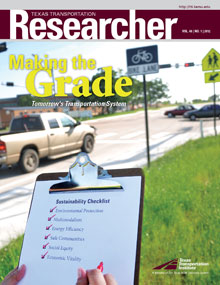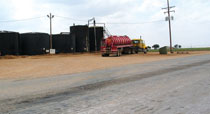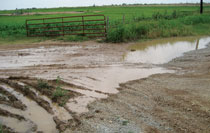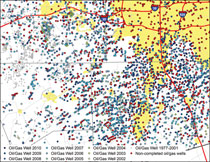In recent years, there has been a boom of energy-related activities in Texas. While these efforts enhance the state’s ability to produce energy reliably, many short- and long-term impacts on the state’s right-of-way and infrastructure are not properly documented.
The Texas Transportation Institute (TTI) recently completed a project to examine some of these impacts.
“The purpose of the project was to measure the impact of the increased level of energy-related activities on the Texas Departments of Transportation’s [TxDOT’s] right-of-way and infrastructure, develop recommendations to reduce and manage TxDOT’s exposure and risk resulting from these activities, and develop recommendations for potential changes to business practices,” says Cesar Quiroga, manager of TTI’s Research and Implementation Office in San Antonio, Texas.
“Pavement was a big part of the project for the researchers,” says TxDOT project director Dale Booth. “The researchers focused their efforts in Abilene, Lubbock and the Dallas-Fort Worth area. And they found quite a bit of distress in those areas related to those industries.”

The researchers focused on the infrastructure impact by heavy trucks and machinery moving in and out of oil and gas well sites, as well as wind farms. Some of the problems observed included the following:
- failures,
- surface ripples,
- tire tracks on unpaved shoulders,
- drainage problems at driveways,
- mud tracking,
- alligator cracking,
- shoulder patches,
- cracked seals and
- loss of surface.
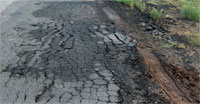
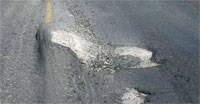
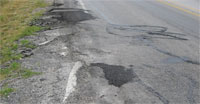
The researchers also collected ground-penetrating radar and falling weight deflectometer data. Considering the increasing level of activity in connection with the Eagle Ford Formation in South Texas, the researchers also met with officials from the Laredo, San Antonio and Yoakum TxDOT districts.
“After we gathered the data, we conducted an evaluation of impacts of energy developments on the transportation infrastructure, including pavement impacts and remaining pavement life, roadside impacts, operational and safety impacts, and economic impacts. We also developed file geodatabases of relevant energy- and transportation-related datasets and provided TxDOT with recommendations on how to alleviate potential problems that may arise with energy-related activities,” says Quiroga.
The researchers used these geodatabases to generate a range of reports mapping the following:
- wind farms in relation to other energy developments as well as transportation datasets;
- wind farms, competitive renewable energy zones and transmission lines;
- pipelines in relation to oil and gas wells;
- permitted (and completed) oil and gas wells over time;
- permitted (but not completed) oil and gas wells;
- oversized/overweight routes in relation to energy developments;
- pavement statistics in relation to energy developments over time; and
- crash locations in relation to energy developments.
Key recommendations at the end of the research included the need to maintain the geodatabase of energy developments to help TxDOT forecast and manage future developments, the need to engage and coordinate with energy developers earlier in the process, and the need to strengthen certain protocols and requirements (e.g., those dealing with triaxial design checks, cross-sectional elements on rural two-lane highways, and driveway permits).
“As energy development continues in our state, especially in the gas-bearing shale formations that have become so busy in the last 10 years, having a statistical basis to show their impacts serves as a springboard for additional funding,” says Booth.
Booth also notes the importance of the geodatabase as a communications and predictor tool for TxDOT.
“As a communications tool, it is a visual way to predict well permits and well development in any area. When you run the program year to year, you can see ‘waves’ of wells progressing across the screen,” says Booth. “If you then show your audience the pavement distress and how that has progressed through the years, it paints a vivid picture of what energy developments in our state are doing to our transportation infrastructure. As a communications tool and predictor of future needs, the geodatabase is the centerpiece of this project.”
